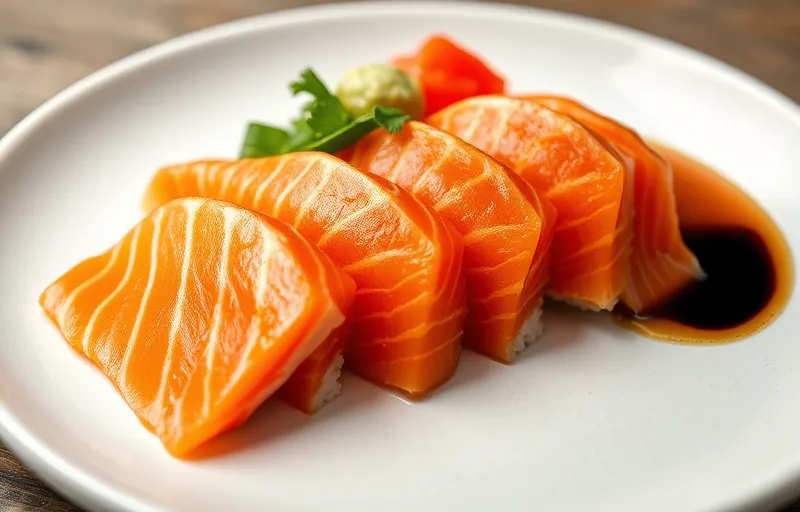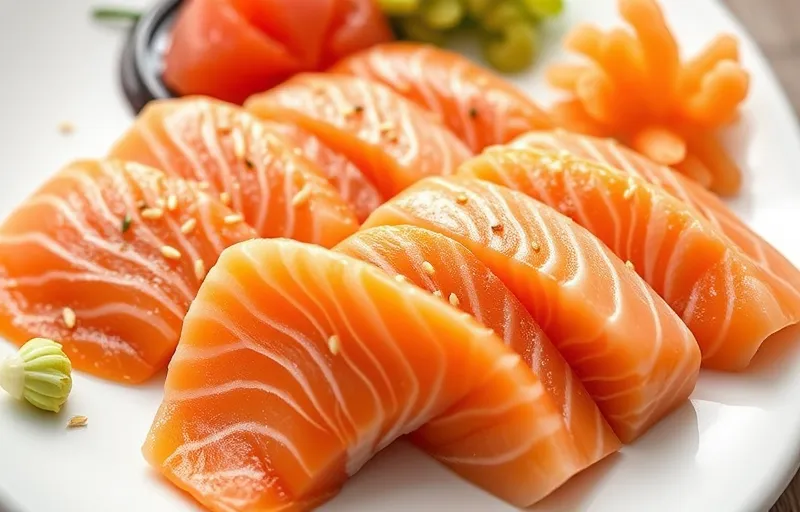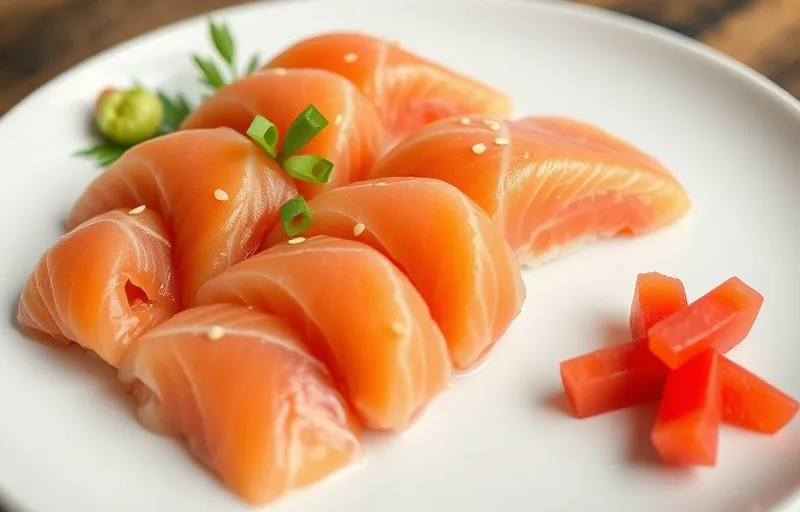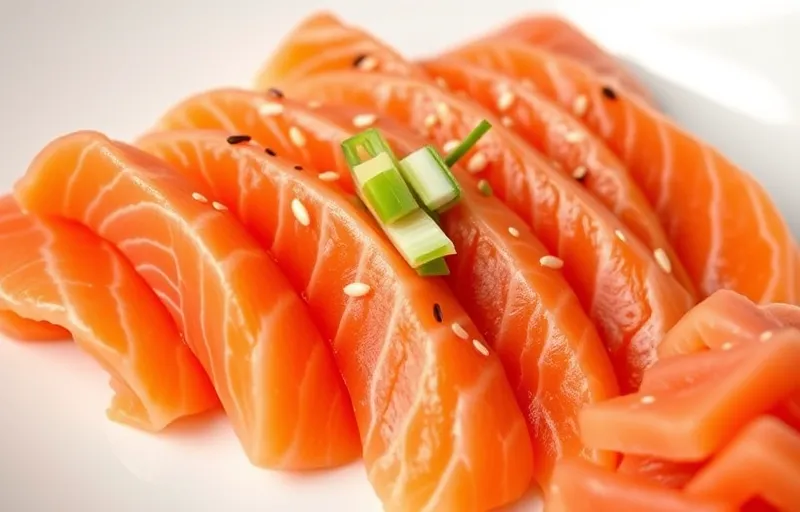Introduction
When it comes to crafting exquisite and flavorful dishes at home, few ingredients rival the elegance and versatility of sushi grade salmon. But what exactly does “sushi grade” mean, and why is it ideal for homemade recipes?
What Is Sushi Grade Salmon?
Sushi grade salmon refers to fish that meets the highest standards for freshness and safety, making it suitable for raw consumption. Unlike regular salmon, sushi grade salmon is carefully inspected and often flash-frozen at extremely low temperatures to kill parasites and preserve its quality. This ensures that every bite is not only delicious but also safe to eat.
Why Choose Sushi Grade Salmon for Your Recipes?
Sushi grade salmon is the gold standard for preparing dishes like sashimi, nigiri, and sushi rolls. Its rich, buttery texture, vibrant color, and delicate flavor make it a standout ingredient. In addition to its superior taste, sushi grade salmon offers numerous health benefits:
- Rich in Omega-3 Fatty Acids: These healthy fats support heart and brain health.
- Packed with Protein: Perfect for muscle repair and overall vitality.
- Loaded with Essential Nutrients: High levels of vitamins D, B12, and selenium contribute to a balanced diet.
What This Guide Offers
Whether you’re a seasoned sushi enthusiast or a beginner looking to experiment, this guide will walk you through everything you need to know about preparing sushi grade salmon at home. From sourcing the freshest fish to creating delicious recipes, you’ll find tips, tricks, and step-by-step instructions to help you master the art of sushi making.
Get ready to elevate your cooking skills and impress your family and friends with stunning, restaurant-quality sushi dishes—all made in the comfort of your kitchen!

What Makes Salmon Sushi Grade?
Definition and Characteristics
To truly understand what makes salmon sushi grade, it’s essential to know how it differs from regular salmon. Sushi grade salmon refers to fish that is safe to eat raw, adhering to rigorous safety and quality standards.
- Freshness: Sushi grade salmon is exceptionally fresh, often handled with care from the moment it’s caught. It undergoes quick processing and freezing to preserve its flavor and quality.
- Texture: The texture is firm yet buttery, making it perfect for slicing thinly for sashimi or layering over rice for nigiri.
- Fat Content: High-quality sushi grade salmon, like fatty cuts from the belly, offers a rich and silky mouthfeel, enhancing its appeal in sushi dishes.
These characteristics ensure sushi grade salmon delivers both exquisite taste and a luxurious dining experience, even in homemade recipes.
Safety Standards for Sushi Grade Fish
Sushi grade fish undergoes strict safety protocols to ensure it’s suitable for raw consumption.
- Eliminating Parasites: Flash-freezing the salmon at ultra-low temperatures is a critical step in making it sushi grade. This process kills any potential parasites, making the fish safe to eat.
- Freezing Guidelines: According to FDA recommendations, fish should be frozen at either:
- -4°F (-20°C) for at least 7 days, or
- -31°F (-35°C) for at least 15 hours.
These standards ensure that the salmon remains fresh while eliminating any health risks.
Understanding these safety measures gives you confidence in selecting and preparing sushi grade salmon at home.
Where to Buy Sushi Grade Salmon
Finding high-quality sushi grade salmon is crucial for a successful dish. Here’s where to look:
- Local Fish Markets: Local fishmongers often carry sushi grade salmon. Ask about its handling and freezing process to ensure it meets safety standards.
- Asian Grocery Stores: Many Asian supermarkets specialize in sushi grade fish, offering both fresh and frozen options. Look for reputable brands with proper labeling.
- Online Suppliers: Trusted online stores like Catalina Offshore and Fulton Fish Market ship sushi grade salmon directly to your doorstep, often with clear freezing and safety details.
Tips for Identifying High-Quality Salmon:
- Appearance: Look for vibrant, evenly colored salmon with a slight sheen.
- Smell: It should have a clean, ocean-like scent, without any strong “fishy” odor.
- Touch: Fresh sushi grade salmon should feel firm to the touch, not slimy or overly soft.
By sourcing your salmon from reliable places and following these tips, you can ensure you’re getting the best product for your homemade sushi creations.
Learn more : Delicious Salmon Kama in Just 30 Minutes
Essential Tips for Preparing Sushi Grade Salmon at Home
How to Handle and Store Sushi Grade Salmon
Proper handling and storage are crucial for maintaining the freshness and safety of sushi grade salmon.
- Refrigeration: Keep your sushi grade salmon refrigerated at a temperature below 40°F (4°C) until you’re ready to use it. Consume it within 24-48 hours for the best quality.
- Freezing: If you plan to store it longer, ensure it’s tightly wrapped in plastic wrap and placed in an airtight container or freezer bag to prevent freezer burn. Maintain a freezer temperature of -4°F (-20°C) or lower.
- Tools Needed:
- A sushi knife with a sharp, thin blade for precise cuts.
- A non-slip cutting board to ensure safety while slicing.
- A damp cloth to wipe the knife clean between cuts to maintain cleanliness.
Cutting Techniques for Sushi and Sashimi
Mastering the art of cutting sushi grade salmon can elevate the presentation and texture of your dishes.
- Preparation:
- Ensure the salmon is cold and firm before slicing. Slightly chilled fish is easier to cut.
- Remove the skin and pin bones using tweezers or a fillet knife.
- Slicing for Nigiri:
- Cut the salmon into 2-3 inch slices, about ¼ inch thick.
- Slice at a slight diagonal angle to create smooth, even pieces.
- Slicing for Sashimi:
- Hold the knife at an angle and use a single, smooth motion to slice through the salmon.
- Aim for slices about ½ inch thick, depending on your preference.
Tips for Perfect Cuts:
- Always cut against the grain to maintain tenderness.
- Avoid sawing motions; use a single, clean stroke with your knife.
- Wipe your knife blade after each cut to prevent sticking.
Pairing Ingredients for an Authentic Taste
Enhance the flavors of your sushi grade salmon with the right pairings:
- Condiments:
- Soy Sauce: A classic accompaniment for dipping sashimi or drizzling over sushi.
- Wasabi: Adds a spicy kick that complements the salmon’s richness.
- Pickled Ginger: Cleanses the palate between bites and balances flavors.
- Complementary Ingredients:
- Avocado: Its creamy texture pairs beautifully with the buttery salmon.
- Cucumber: Adds a refreshing crunch to rolls or sushi bowls.
- Sushi Rice: Properly seasoned rice (with rice vinegar, sugar, and salt) is the perfect foundation for nigiri or rolls.
- Optional Extras:
- Sprinkle sesame seeds or scallions for added texture and flavor.
- Drizzle spicy mayo or ponzu sauce for a gourmet twist.
By following these tips, you can handle, cut, and pair sushi grade salmon like a pro, creating restaurant-quality dishes in your own kitchen!

Top 3 Easy Sushi Grade Salmon Recipes
Classic Salmon Sashimi
If you want to enjoy the pure, unadulterated flavor of sushi grade salmon, sashimi is the perfect dish.
- Ingredients:
- 6–8 oz sushi grade salmon
- Soy sauce (for dipping)
- Wasabi (optional)
- Pickled ginger (optional)
- Preparation Steps:
- Ensure the salmon is chilled and firm.
- Remove the skin and pin bones, if necessary.
- Slice the salmon into even pieces, about ½ inch thick and 2–3 inches long. Use a sharp knife to create clean cuts.
- Serving Suggestions:
- Arrange the salmon slices on a plate in an aesthetically pleasing manner.
- Serve with a small dish of soy sauce and a dab of wasabi on the side.
- Add a few pieces of pickled ginger to cleanse the palate between bites.
Salmon Nigiri with Perfectly Seasoned Rice
Nigiri combines the richness of sushi grade salmon with perfectly seasoned rice for a balanced bite.
- Ingredients:
- 6–8 oz sushi grade salmon
- 1 cup sushi rice (cooked and cooled)
- 2 tbsp rice vinegar
- 1 tbsp sugar
- ½ tsp salt
- Soy sauce (for dipping)
- Preparing Sushi Rice:
- Mix rice vinegar, sugar, and salt until dissolved.
- Gently fold the mixture into the cooked rice using a wooden spoon, being careful not to mash the grains. Let the rice cool to room temperature.
- Assembling the Nigiri:
- Slice the salmon into 2-inch pieces about ¼ inch thick.
- Wet your hands with water and shape the rice into small, oval mounds.
- Lay a piece of salmon on top of each rice mound, pressing gently to secure it.
- Garnishing Tips:
- Optional: Add a thin strip of nori (seaweed) around the center for added flair.
- Serve with soy sauce and a dab of wasabi for dipping.
Salmon Maki Roll with Avocado and Cucumber
Maki rolls are a fun and versatile way to use sushi grade salmon, with endless opportunities to customize.
- Ingredients:
- 6–8 oz sushi grade salmon
- 1 cup sushi rice (cooked and seasoned)
- 1 sheet of nori (seaweed)
- ½ avocado (sliced thinly)
- ¼ cucumber (cut into thin matchsticks)
- Bamboo rolling mat
- Rolling Techniques:
- Lay the bamboo mat flat and place the nori sheet on top, shiny side down.
- Spread a thin layer of seasoned sushi rice over the nori, leaving about 1 inch at the top edge uncovered.
- Arrange slices of salmon, avocado, and cucumber horizontally across the center of the rice.
- Rolling and Cutting:
- Use the bamboo mat to roll the nori tightly, starting from the edge closest to you.
- Apply gentle pressure to form a compact roll.
- Slice the roll into even pieces using a sharp knife, cleaning the blade between cuts.
- Optional Twists:
- Drizzle spicy mayo or sprinkle sesame seeds on top for extra flavor.
- Garnish with thinly sliced scallions or serve with ponzu sauce for a zesty kick.
These recipes are simple yet delicious ways to showcase sushi grade salmon at home. Whether you’re indulging in sashimi, crafting elegant nigiri, or rolling up flavorful maki, these dishes are sure to impress!
Health Benefits of Sushi Grade Salmon
Rich Source of Omega-3 Fatty Acids
Sushi grade salmon is renowned for being an exceptional source of omega-3 fatty acids, essential nutrients that offer a wide array of health benefits:
- Heart Health: Omega-3s help reduce inflammation, lower triglyceride levels, and improve overall cardiovascular health. They also contribute to regulating blood pressure and reducing the risk of heart disease.
- Brain Health: Omega-3 fatty acids, particularly DHA, are vital for brain function. They support cognitive health, improve memory, and may reduce the risk of neurodegenerative diseases like Alzheimer’s.
- Mood Regulation: Studies suggest omega-3s can improve mood and reduce symptoms of depression and anxiety.
Incorporating sushi grade salmon into your diet is a delicious way to boost your intake of these powerful nutrients.
High-Quality Protein for Muscle and Repair
Sushi grade salmon is not only delicious but also a fantastic source of high-quality protein:
- Muscle Building and Repair: Protein is essential for repairing tissues and building muscle, making salmon an excellent choice for athletes and fitness enthusiasts.
- Energy and Satiety: Protein keeps you full for longer, reducing hunger and aiding in weight management.
- Essential Amino Acids: Sushi grade salmon provides all nine essential amino acids your body needs for optimal functioning.
By adding sushi grade salmon to your meals, you’re fueling your body with the nutrients it needs to recover, grow, and thrive.
Low-Calorie, Nutrient-Dense Food
One of the standout qualities of sushi grade salmon is its ability to deliver essential nutrients without piling on the calories:
- Vitamin D: Supports bone health, immune function, and mood regulation. Salmon is one of the best natural sources of this vital nutrient.
- B Vitamins: Sushi grade salmon is packed with B12, B6, and niacin, all of which play critical roles in energy production, brain function, and red blood cell formation.
- Selenium: This powerful antioxidant helps protect cells from damage and supports a healthy immune system.
- Low in Calories, High in Nutrients: A typical serving of salmon provides a wealth of vitamins and minerals with relatively few calories, making it an excellent choice for those seeking a nutrient-dense diet.
By enjoying sushi grade salmon, you’re not just treating your taste buds—you’re nourishing your body with a powerhouse of nutrients that support overall health and well-being. It’s a perfect example of how food can be both indulgent and beneficial!
Common Questions About Sushi Grade Salmon
How Do I Know If My Salmon Is Safe to Eat Raw?
Ensuring that your salmon is safe for raw consumption is essential when preparing sushi grade dishes. Here’s what to look for:
- Signs of Freshness:
- Bright Color: Fresh sushi grade salmon should have a vibrant pink or orange hue, free from any dullness or discoloration.
- Firm Texture: The flesh should be firm and bounce back when gently pressed, not mushy or slimy.
- Clean Smell: High-quality salmon will have a light, oceanic scent, not a strong or fishy odor.
- Reputable Source:
- Purchase from trusted fish markets, seafood stores, or online suppliers specializing in sushi grade fish.
- Look for labels like “sushi grade” or “sashimi grade,” which indicate that the fish meets specific safety standards.
Can I Use Frozen Salmon for Sushi?
Yes, frozen salmon can be used for sushi as long as it has been handled and stored properly.
- Safety First:
- Freezing is a critical step to eliminate parasites. The FDA recommends freezing fish at:
- -4°F (-20°C) or below for at least 7 days (commercial freezing)
- -31°F (-35°C) or below for 15 hours (blast freezing).
- These temperatures ensure that the fish is safe to eat raw.
- Freezing is a critical step to eliminate parasites. The FDA recommends freezing fish at:
- Thawing Properly:
- Thaw the salmon slowly in the refrigerator overnight or under cold running water for faster results.
- Avoid microwaving or leaving it at room temperature, as this can compromise texture and safety.
- Look for “Previously Frozen” Label:
- Many sushi grade salmon options in stores are flash-frozen immediately after being caught, preserving quality and safety.

What Are Some Common Mistakes to Avoid?
Even with high-quality sushi grade salmon, mistakes in handling or preparation can affect the final result. Here are a few to avoid:
- Overhandling the Salmon:
- Touching the fish too much can transfer heat and break down its delicate texture. Use clean, cold hands or tools to handle it minimally.
- Improper Slicing:
- Using a dull knife can tear the flesh and ruin the presentation. Always use a sharp sushi knife and cut in one smooth motion.
- Cutting with the grain instead of against it can make the salmon tougher and less appealing.
- Poor Ingredient Pairings:
- Overpowering the delicate flavor of the salmon with strong or mismatched ingredients (e.g., excessive wasabi or heavy sauces).
- Skipping traditional accompaniments like soy sauce, wasabi, or pickled ginger, which enhance the taste and balance the meal.
By addressing these common questions and mistakes, you can feel confident in your ability to select, handle, and prepare sushi grade salmon safely and deliciously. This knowledge ensures that your sushi-making experience is not only enjoyable but also worry-free!
Conclusion
Sushi grade salmon is not only a versatile and delicious ingredient but also a powerhouse of health benefits. Its freshness, rich flavor, and high nutritional value make it the perfect choice for creating restaurant-quality dishes at home.
By understanding how to select, handle, and prepare sushi grade salmon, you can elevate your culinary skills and enjoy authentic sushi experiences without leaving your kitchen. Whether you’re savoring the simplicity of sashimi, mastering the art of nigiri, or rolling up a flavorful maki, the possibilities are endless.
We encourage you to try the recipes shared in this guide and get creative with your own variations. Experiment with complementary ingredients, flavors, and presentation styles to make your sushi creations truly unique.
Call-to-Action:
Loved these recipes or have your own sushi grade salmon tips to share? Leave a comment below! Don’t forget to share this guide with friends and family who might want to join you on your sushi-making journey. Let’s spread the joy of making delicious sushi at home!
Table of Contents

